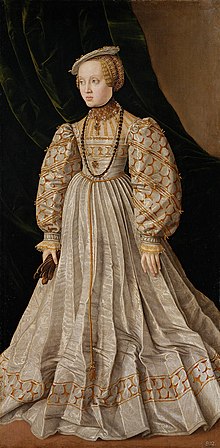Anna of Austria (1528–1590)



Anna of Austria (born July 7, 1528 in Prague , † October 16, 1590 in Munich ) was an Archduchess of Austria and by marriage Duchess of Bavaria .
Life
Anna was a daughter of the future Emperor Ferdinand I (1503–1564) from his marriage to Anna Jagiello (1503–1547), daughter of King Vladislav II of Bohemia and Hungary . Anna was betrothed several times as a little girl, first to Prince Theodor of Bavaria (1526–1534), then to Duke Karl von Orleans . But both died before they got married.
Anna finally married at the age of 17 on July 4, 1546 in Regensburg the future Duke Albrecht V of Bavaria (1528–1579), the brother of her first fiancé. The dowry was 50,000 guilders. The couple lived at Trausnitz Castle in Landshut until Albrecht took office . Due to the close connection between Bavaria and the imperial family, Duke Wilhelm IV of Bavaria allowed the troops of his son's father-in-law to pass through Bavarian territory and the siege of Ingolstadt in the Schmalkaldic War .
Anna and Albrecht von Bayern had a great influence on the intellectual life of the Residenz and established Munich's reputation as a city of art through considerable financial donations and the founding of various museums. Anna and Albrecht are also considered to be the patrons of the painter Hans Mielich , brought Orlando di Lasso to court and, with their book collection, laid the foundation stone for the Bavarian State Library.
Anna, described as pious, supported the Catholic monastery in Vadstena in Reformed Sweden with substantial donations of money and was considered a supporter of the Franciscan order . In the Neue Veste in Munich Anna also took part in the strict upbringing of her grandson, the future Elector Maximilian I of Bavaria , who was named after her brother. The so-called widow's building in the Munich Residenz was built for the art-loving Anna, where she held court until her own death after her husband's death in 1579. She had a widow's allowance of 200,000 guilders at her disposal.
As a direct descendant of Archduchess Anna, the future Emperor Charles VII Albrecht established his claim to the Habsburg hereditary lands. He relied on the will of Emperor Ferdinand I, who had determined that after the extinction of his male heirs, his daughter Anna and her male descendants should receive the inheritance. This provision was also part of the marriage contract of Anna and Albrecht, in which it was stipulated that after the extinction of the German Habsburgs Bohemia , Silesia and Moravia and after the extinction of the line of the Spanish Habsburgs, Hungary and the hereditary lands should also fall to Anna and her male descendants .
progeny
Anna had the following children from their marriage:
- Karl (* / † 1547)
- Wilhelm V the Pious (1548–1626), Duke of Bavaria
- ⚭ 1568 Princess Renata of Lorraine (1544–1602)
- Ferdinand (1550-1608)
- ⚭ 1588 ( morganatic ) Maria Pettenbeck (1574–1614)
- Maria Anna (1551-1608)
- ⚭ 1571 Archduke Karl of Austria-Styria (1540–1590)
- Maximiliana Maria (1552-1614)
- Friedrich (1553–1554)
- Ernst (1554–1612), Elector and Archbishop of Cologne
literature
- Constantin von Wurzbach : Anna of Austria, Duchess of Bavaria . No. 26. In: Biographical Lexicon of the Empire of Austria . 6th part. Kaiserlich-Königliche Hof- und Staatsdruckerei, Vienna 1860, p. 151 ( digitized version ).
Web links
- Anna Archduchess of Austria on thepeerage.com , accessed on August 12, 2015.
- Book of treasures of Duchess Anna of Bavaria - BSB Cod.icon. 429, Munich, 1552 - 1555
Individual evidence
- ^ Moritz Jungermann: Albrecht V, the generous, Duke of Bavaria , Hübschmann, 1843, p. 10
- ↑ Alte Pinakothek: selected works , Pinakothek-Dumont, 2005, p. 145
- ^ Gotthilf Heinrich von Schubert: The history of Bavaria for schools , Königlicher Central-Schulbücher-Verl., 1860, p. 90
- ^ Moritz Jungermann: Albrecht V, the generous, Duke of Bavaria , Hübschmann, 1843, p. 117
- ^ Brigitte Hamann: Die Habsburger: ein biographisches Lexikon , Piper, 1988, p. 55
- ↑ Dieter Albrecht: Maximilian I of Bavaria 1573-1651 , Oldenbourg Wissenschaftsverlag, 1998, p. 89
- ↑ Christina Hofmann-Randall: The Erlanger Castle as a widow's seat , University Library, 2002, p. 23
- ^ Maximilian V. Sattler: Textbook of Bavarian History , Lindauer, 1868, p. 292
- ↑ Karl von Spruner: Guide to the history of Bavaria , Buchner, 1853, p. 81
| predecessor | Office | successor |
|---|---|---|
| Maria Jacobea | Duchess of Bavaria 1550–1579 |
Renata |
| personal data | |
|---|---|
| SURNAME | Anna of Austria |
| BRIEF DESCRIPTION | Duchess of Bavaria |
| DATE OF BIRTH | July 7, 1528 |
| PLACE OF BIRTH | Prague |
| DATE OF DEATH | October 16, 1590 |
| Place of death | Munich |